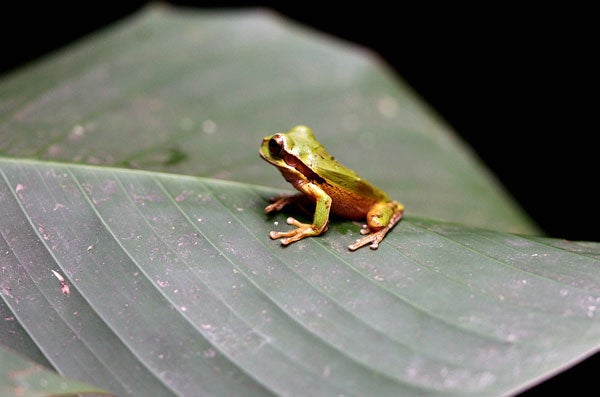Frog numbers in peril from spread of killer fungus

The Chinese calendar may designate 2008 as the Year of the Rat, but in wildlife terms it is very definitely the year of the frog.
Conservationists are dedicating the next 12 months to saving frogs and other amphibians, such as toads, newts and salamanders, which are now threatened as never before by a disease which seems to be exacerbated by global warming.
It is thought that between a third and half of the world's 6,000 amphibian species could be wiped out in the coming decades by a species of chytrid fungus, which kills by attacking the skin of frogs, which they use to breathe. Warmer temperatures likely to have been caused by climate change appear to make its effects worse.
Already, it is thought that 165 species may have become extinct with 34 confirmed, one extinct in the wild but surviving in captivity and 130 not found in recent years another 500 species are so threatened that they cannot be saved in the wild, and so a major intervention is planned.
Amphibian Ark, the Year of the Frog's key project, will bring together 500 of the world's leading zoos to try to establish breeding populations of the threatened species in captivity, at an estimated cost of 30m. It is being co-ordinated by the International Union for the Conservation of Nature and its Amphibian Specialist Group, and the World Association of Zoos and Aquariums.
The patron of the Year of the Frog is the British naturalist, Sir David Attenborough, and he has issued an impassioned plea for support for the campaign. "Today, amphibians can be found in enormous variety and occupy a wide range of water and land habitats, except for the oceans and the frozen polar regions," Sir David said. "They are so familiar to most people that they have become part of the myths, legends, and folk tales of many cultures. Yet their habitats are being destroyed at such a speed that now many species may disappear before we even discover that they exist. Infections of chytrid fungus, for which there is no known cure, are today spreading rapidly and threatening entire species. There is thus the real possibility that much of an entire category of animals may become extinct unless we prepare to act quickly."
Captive breeding had been shown to be one of the most important and appropriate ways to slow down the effects of the crisis, he said. "Selected species, bred in favourable ex-situ conditions, can multiply and prosper to such an extent that populations can be released into secure environments in the wild," said Sir David. "The global zoo and aquarium community have taken on this challenge with enthusiasm and are providing appropriate facilities and breeding grounds within their institutions. But implementation calls for financial and political support from all parts of the world."
Sir David added: "Without an immediate and sustained conservation effort to support captive management, hundreds of species of these wonderful creatures could become extinct in our own lifetime."
The particular species of chytrid fungus doing the damage, Batrachochytrium dendrobatidis, or Bd, was first described as infecting amphibians, often fatally, only in 1999, but since that time it has gone on to do tremendous damage.
The disease is thought to have originated in South Africa, where the earliest record occurs in a museum specimen from the 1930s, and was initially spread by the commercial trade in clawed frogs.
From the site of its introduction, Bd spreads through water courses and amphibian-to-amphibian contact. Where it thrives generally in moist, cool habitats 50 per cent of amphibian species and 80 per cent of individuals can be expected to die within a year.
Subscribe to Independent Premium to bookmark this article
Want to bookmark your favourite articles and stories to read or reference later? Start your Independent Premium subscription today.

Join our commenting forum
Join thought-provoking conversations, follow other Independent readers and see their replies